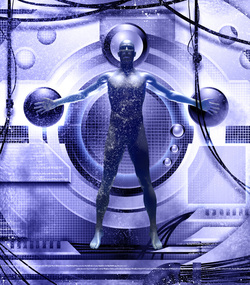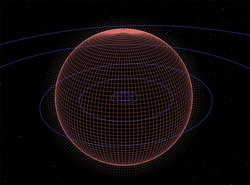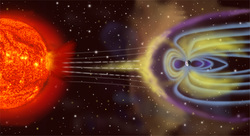Superhuman powers are available to common citizenry

The nanotechnology of recent decades has conferred powers to citizens that would be considered superhuman by 21st century standards. These upgraded "transhumans" could perform feats regarded as Godlike to denizens of earlier times.
A suitably upgraded individual - if transported back to the year 2000 - would be impervious to weaponry and nearly impossible to contain. They could morph their body into a seemingly infinite variety of forms depending on the situation encountered.
If trapped in a maximum security prison, for instance, they could alter their own molecular structure, allowing them to walk through walls. They could broadcast electromagnetic pulse waves to disable electronic devices, vehicles and other objects. Bullets and other projectiles would pass through them with no effect. Microscopic cameras, distributed throughout their body, would function as an all-round 360° sensor - covering the entire electromagnetic spectrum and making it impossible for an attacker to surprise them.
They could sprint at lightning speed and cross a variety of dangerous terrain types: even molten lava would present no obstacle to them. If necessary, they could levitate from ground level to the roof of a skyscraper in seconds. They could turn themselves invisible, morph into another person entirely, or stretch their limbs like elastic.
In many ways, they would resemble a comic book superhero or video game character.
They could manipulate their environment in various ways, generating enough body heat to light a fire, for example, or turning inanimate objects into advanced nanotechnology tools, or modifying the properties of liquids. They could heal a wounded person just by touching them. They could read thoughts and emotions, or extract recent memories.
If standing near others of their kind, they could link and combine their powers to even greater levels – harnessing the power of local weather, for example, or lifting objects weighing thousands of tons.
Their sensory capabilities would be phenomenal. This 24th century person could view individual atoms with the naked eye; or if they wanted to, use their telescopic vision to see distant astronomical objects. They could hear a whisper from miles away, or filter specific voices from a cacophony of background noise. They could determine a precise chemical composition just by tasting, touching or smelling it.
Due to their various biotechnology aids and physical upgrades, they would never require sleep. They could even survive without food and water - living instead off the energy of their surrounding environment, which would be absorbed into their photosynthetic, piezoelectric skin. This same external layering would keep them at peak levels of physical performance, as well as shielding them from the elements.
In fact, many citizens of today have abandoned their homes altogether and taken to a nomadic lifestyle, for this and other reasons. Often, a "home" of today is little more than a small booth or alcove in the street, where a person can temporarily recharge and recuperate, or utilise the greater powers of the net. Even a person's body is often temporary, as they shift between various real world and digital environments. Much of the Earth is now being transformed into a gigantic computer grid where individuals can physically "plug" themselves in.
Not everyone has opted to make this transition. Even now, there are segments of society which are adamant in maintaining a natural, minimally upgraded human body. These people are now a definite minority, however, given the practical immortality and other benefits offered by transhumanism.
A suitably upgraded individual - if transported back to the year 2000 - would be impervious to weaponry and nearly impossible to contain. They could morph their body into a seemingly infinite variety of forms depending on the situation encountered.
If trapped in a maximum security prison, for instance, they could alter their own molecular structure, allowing them to walk through walls. They could broadcast electromagnetic pulse waves to disable electronic devices, vehicles and other objects. Bullets and other projectiles would pass through them with no effect. Microscopic cameras, distributed throughout their body, would function as an all-round 360° sensor - covering the entire electromagnetic spectrum and making it impossible for an attacker to surprise them.
They could sprint at lightning speed and cross a variety of dangerous terrain types: even molten lava would present no obstacle to them. If necessary, they could levitate from ground level to the roof of a skyscraper in seconds. They could turn themselves invisible, morph into another person entirely, or stretch their limbs like elastic.
In many ways, they would resemble a comic book superhero or video game character.
They could manipulate their environment in various ways, generating enough body heat to light a fire, for example, or turning inanimate objects into advanced nanotechnology tools, or modifying the properties of liquids. They could heal a wounded person just by touching them. They could read thoughts and emotions, or extract recent memories.
If standing near others of their kind, they could link and combine their powers to even greater levels – harnessing the power of local weather, for example, or lifting objects weighing thousands of tons.
Their sensory capabilities would be phenomenal. This 24th century person could view individual atoms with the naked eye; or if they wanted to, use their telescopic vision to see distant astronomical objects. They could hear a whisper from miles away, or filter specific voices from a cacophony of background noise. They could determine a precise chemical composition just by tasting, touching or smelling it.
Due to their various biotechnology aids and physical upgrades, they would never require sleep. They could even survive without food and water - living instead off the energy of their surrounding environment, which would be absorbed into their photosynthetic, piezoelectric skin. This same external layering would keep them at peak levels of physical performance, as well as shielding them from the elements.
In fact, many citizens of today have abandoned their homes altogether and taken to a nomadic lifestyle, for this and other reasons. Often, a "home" of today is little more than a small booth or alcove in the street, where a person can temporarily recharge and recuperate, or utilise the greater powers of the net. Even a person's body is often temporary, as they shift between various real world and digital environments. Much of the Earth is now being transformed into a gigantic computer grid where individuals can physically "plug" themselves in.
Not everyone has opted to make this transition. Even now, there are segments of society which are adamant in maintaining a natural, minimally upgraded human body. These people are now a definite minority, however, given the practical immortality and other benefits offered by transhumanism.
Progress with Mars terraforming

The first lakes and seas are beginning to form on Mars.
In the lowest altitude regions, a variety of plant life has been introduced. The air pressure and temperature is even high enough for certain arthropods and insects to survive.
Open air exploration for humans is still limited to those with cyborg bodies, however.
In the lowest altitude regions, a variety of plant life has been introduced. The air pressure and temperature is even high enough for certain arthropods and insects to survive.
Open air exploration for humans is still limited to those with cyborg bodies, however.
Mars has been terraformed

By the middle of this millenium, the Red Planet has turned from a cold, dead world into a lush, Eden-like paradise. This monumental achievement has been the result of human collaboration on a planet-wide scale. It has created whole new industries, countless millions of jobs and undreamed of technologies.
The project was initiated in the early 22nd century. From the outset, it faced major hurdles. Aside from the sheer scale of geo-engineering an entire world, there were political, social and cultural issues too. Many of the early settlers on Mars actually wished for it to remain in its raw, primeval state. Some of them had an almost spiritual connection to the planet. Like certain environments on Earth, they believed it held an intrinsic worth and unique value that should never be replaced. To better it with manmade artificial processes would somehow make it less natural, less real.
These "Reds", as they came to be known, were a potent force during the early Martian government. They were a thorn in the side of planning authorities, who faced not only protests and demonstrations, but direct sabotaging of industrial activity from some of the more extreme individuals.
On the opposing side of this debate were the "Greens", initially consisting of mostly corporate interests. They included a greater proportion of cyborgs and transhumans, who became adapted to the environment of Mars at an earlier stage and were thus able to survive in the lower air pressures.
Over time, the power and influence of the Greens began to dominate. Improved security measures were introduced, guarding much of the infrastructure and terraforming equipment from attack.
Giant solar mirrors were placed in orbit. Measuring tens of kilometres across, these reflected and focussed the Sun's rays onto the poles.
The project was initiated in the early 22nd century. From the outset, it faced major hurdles. Aside from the sheer scale of geo-engineering an entire world, there were political, social and cultural issues too. Many of the early settlers on Mars actually wished for it to remain in its raw, primeval state. Some of them had an almost spiritual connection to the planet. Like certain environments on Earth, they believed it held an intrinsic worth and unique value that should never be replaced. To better it with manmade artificial processes would somehow make it less natural, less real.
These "Reds", as they came to be known, were a potent force during the early Martian government. They were a thorn in the side of planning authorities, who faced not only protests and demonstrations, but direct sabotaging of industrial activity from some of the more extreme individuals.
On the opposing side of this debate were the "Greens", initially consisting of mostly corporate interests. They included a greater proportion of cyborgs and transhumans, who became adapted to the environment of Mars at an earlier stage and were thus able to survive in the lower air pressures.
Over time, the power and influence of the Greens began to dominate. Improved security measures were introduced, guarding much of the infrastructure and terraforming equipment from attack.
Giant solar mirrors were placed in orbit. Measuring tens of kilometres across, these reflected and focussed the Sun's rays onto the poles.
Humanity is becoming a Type 2 civilisation on the Kardashev scale

The exponential growth of AI is allowing the manipulation of matter on scales barely dreamed of before. The largest structure now being built in space is a "Dyson Sphere". This hollow shell is of such gargantuan proportions that its radius stretches from the Sun to beyond the orbit of Jupiter.
Under the direction of a Godlike superintelligence, vast swarms of automated, self-replicating ships are building it - using material from the asteroid field, Kuiper Belt and Oort Cloud.
The sphere's primary purpose is to harvest literally all of the energy output from the Sun: some 386 yottajoules (YJ) per second. However, it also serves the function of shielding our inner solar system from gamma rays and other incoming hazards. Even the potential possibility of alien invasion has been taken into consideration during the sphere's design.
The interior walls have a gravitational field of 1G and are made from wholly new states of matter that were unknown to science in previous centuries. These can withstand the colossal tensile forces required to maintain structural integrity. This curved, impossibly large surface - equivalent to billions of Earths - is becoming a habitat for many sentient lifeforms, with portions being terraformed and given a stable atmosphere, oceans and landmass. A sizeable percentage of citizens are now migrating to these strange artificial worlds. This includes a diverse mix of biological humans, as well as transhumans, synthetics, clones, androids, sentient animals and other communities.
A series of additional Dyson Spheres are being constructed around neighbouring star systems - some even larger.
Having begun its journey to the stars in the 22nd century, humanity is reaching a landmark in its colonisation of space. A region nearly 1,000 light years in radius has now been explored (or about 2 percent of the total length of our galaxy). The light speed barrier has yet to be exceeded, however.
Under the direction of a Godlike superintelligence, vast swarms of automated, self-replicating ships are building it - using material from the asteroid field, Kuiper Belt and Oort Cloud.
The sphere's primary purpose is to harvest literally all of the energy output from the Sun: some 386 yottajoules (YJ) per second. However, it also serves the function of shielding our inner solar system from gamma rays and other incoming hazards. Even the potential possibility of alien invasion has been taken into consideration during the sphere's design.
The interior walls have a gravitational field of 1G and are made from wholly new states of matter that were unknown to science in previous centuries. These can withstand the colossal tensile forces required to maintain structural integrity. This curved, impossibly large surface - equivalent to billions of Earths - is becoming a habitat for many sentient lifeforms, with portions being terraformed and given a stable atmosphere, oceans and landmass. A sizeable percentage of citizens are now migrating to these strange artificial worlds. This includes a diverse mix of biological humans, as well as transhumans, synthetics, clones, androids, sentient animals and other communities.
A series of additional Dyson Spheres are being constructed around neighbouring star systems - some even larger.
Having begun its journey to the stars in the 22nd century, humanity is reaching a landmark in its colonisation of space. A region nearly 1,000 light years in radius has now been explored (or about 2 percent of the total length of our galaxy). The light speed barrier has yet to be exceeded, however.
Polar reversal of the Earth

Polar reversals have occurred many times before in Earth's history - typically every 300,000 years. The last time was around 780,000 BC. This means the planet is long overdue for such an event.
From 1900 onwards, the intensity of Earth's magnetic field was known to be declining by six percent each century. By 3500, the poles are beginning to completely reverse.
Charged particles from the Sun affect satellites and other near-Earth vessels which lack adequate protection. However, plants and animals on Earth are unaffected. During the reversal, the solar wind induces a sufficient magnetic field in the ionosphere, temporarily shielding the surface in the absence of the normal magnetic field.
From 1900 onwards, the intensity of Earth's magnetic field was known to be declining by six percent each century. By 3500, the poles are beginning to completely reverse.
Charged particles from the Sun affect satellites and other near-Earth vessels which lack adequate protection. However, plants and animals on Earth are unaffected. During the reversal, the solar wind induces a sufficient magnetic field in the ionosphere, temporarily shielding the surface in the absence of the normal magnetic field.
Computer science is reaching its ultimate potential

The biological and technological descendants of humanity are nearing the perfection of computer science. Hardware and software is becoming the absolute fastest, most efficient it can ever possibly be, within the known laws of physics.
From this point onwards, computer science becomes obsolete as a field of study - the only "unknowns" left for scientists to discover will be in other areas of science.
From this point onwards, computer science becomes obsolete as a field of study - the only "unknowns" left for scientists to discover will be in other areas of science.
